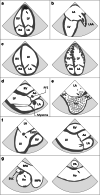Cardiac Imaging After Ischemic Stroke or Transient Ischemic Attack
- PMID: 32607785
- PMCID: PMC7326893
- DOI: 10.1007/s11910-020-01053-3
Cardiac Imaging After Ischemic Stroke or Transient Ischemic Attack
Abstract
Purpose of review: Cardiac imaging after ischemic stroke or transient ischemic attack (TIA) is used to identify potential sources of cardioembolism, to classify stroke etiology leading to changes in secondary stroke prevention, and to detect frequent comorbidities. This article summarizes the latest research on this topic and provides an approach to clinical practice to use cardiac imaging after stroke.
Recent findings: Echocardiography remains the primary imaging method for cardiac work-up after stroke. Recent echocardiography studies further demonstrated promising results regarding the prediction of non-permanent atrial fibrillation after ischemic stroke. Cardiac magnetic resonance imaging and computed tomography have been tested for their diagnostic value, in particular in patients with cryptogenic stroke, and can be considered as second line methods, providing complementary information in selected stroke patients. Cardiac imaging after ischemic stroke or TIA reveals a potential causal condition in a subset of patients. Whether systematic application of cardiac imaging improves outcome after stroke remains to be established.
Keywords: Computed tomography; Echocardiography; Embolism; Ischemic stroke; Magnetic resonance imaging; Transient ischemic attack.
Conflict of interest statement
RBS reports speaking fees from Bristol-Myers Squibb/Pfizer. RBS further received funding from the European Union’s Horizon 2020 research and innovation programme under the (grant agreement No. 847770, AFFECT-EU), the European Research Council (ERC) under the European Union’s Horizon 2020 research and innovation programme (grant agreement No. 648131), and ERACoSysMed3 (031L0239) and German Center for Cardiovascular Research (DZHK e.V.) (81Z1710103). KGH reports consulting fees/lecture honoraria from Bayer Healthcare, Biotronik, Boehringer Ingelheim, Bristol-Myers Squibb, Daiichi Sankyo, Edwards Lifesciences, Medronic, Pfizer, Sanofi, W.L. Gore and Associates, and study grants from Bayer HealthCare and Sanofi. SC reports no conflict of interest.
Figures

References
-
- Adams HP, Jr., Bendixen BH, Kappelle LJ, Biller J, Love BB, Gordon DL, Marsh 3rd EE Classification of subtype of acute ischemic stroke. Definitions for use in a multicenter clinical trial. TOAST. Trial of Org 10172 in Acute Stroke Treatment. Stroke. 1993;24(1):35–41. - PubMed
-
- Kolominsky-Rabas PL, Weber M, Gefeller O, Neundoerfer B, Heuschmann PU. Epidemiology of ischemic stroke subtypes according to TOAST criteria: incidence, recurrence, and long-term survival in ischemic stroke subtypes: a population-based study. Stroke. 2001;32(12):2735–2740. doi: 10.1161/hs1201.100209. - DOI - PubMed
-
- Pepi M, Evangelista A, Nihoyannopoulos P, Flachskampf FA, Athanassopoulos G, Colonna P, Habib G, Ringelstein EB, Sicari R, Zamorano JL, on behalf of the European Association of Echocardiography. Document Reviewers. Sitges M, Caso P. Recommendations for echocardiography use in the diagnosis and management of cardiac sources of embolism: European Association of Echocardiography (EAE) (a registered branch of the ESC) Eur J Echocardiogr. 2010;11(6):461–476. doi: 10.1093/ejechocard/jeq045. - DOI - PubMed
Publication types
MeSH terms
LinkOut - more resources
Full Text Sources
Medical
Research Materials

